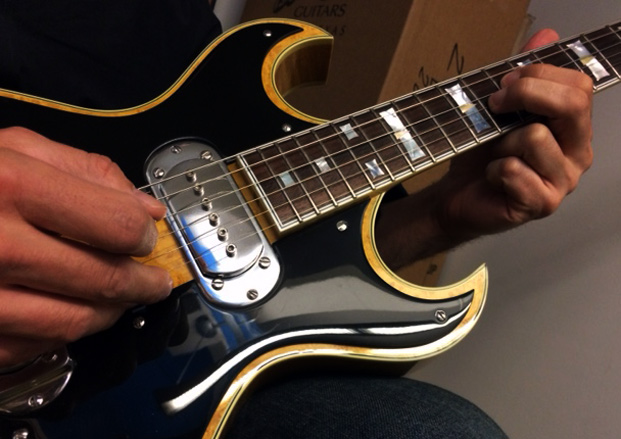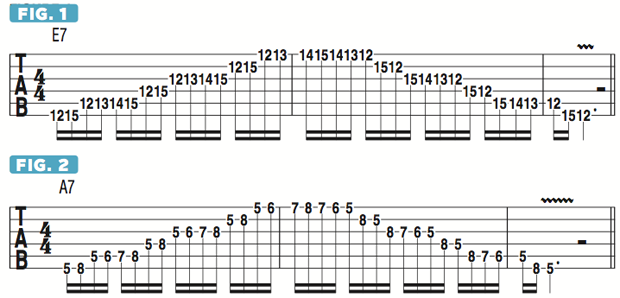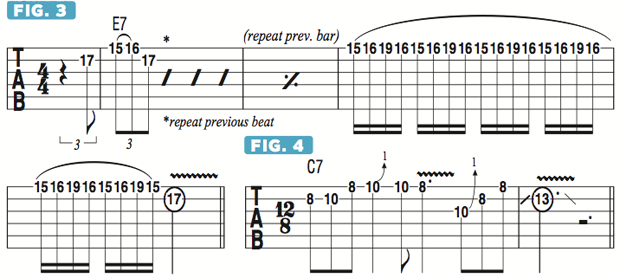Infusing Dark Heavy Metal Riffs with a Touch of Blues

To my mind, it’s impossible to become a great metal soloist without having an appreciation and something of an understanding of the blues and some of the techniques associated with blues guitar.
Most, if not all, of the greatest metal masters ever, players such as Randy Rhoads, Eddie Van Halen, Ritchie Blackmore, Dimebag Darrell and Michael Schenker, were very much inspired by the blues, at the very least in their early days as players, if not throughout their careers.
Learning to emulate the blues guitar techniques of B.B. King, Albert King and all the blues masters is of vital importance to metal as well as blues and rock guitarists, and that is what I would like to explore in this month’s column. The scale most closely associated with the blues is the appropriately named blues scale, spelled, intervallically: one (the root), flatted third, fourth, flatted fifth, flatted seventh.
In FIGURE 1, I’ve forged a riff that begins by outlining the structure of the E blues scale (E G A Bb B) but then veers off the rails a bit as it climbs, lending a twisted metal quality to the phrase. As I ascend the A string, I play four chromatic notes—A Bb B C—after which I take the physical-visual shapes played on the bottom two strings and apply them to the D and G strings, and then to the B and high E strings.
I then descend through the entire pattern using the same notes, played in reverse order. The fact that the line is not based on any specific scale gives it an unusual melodic quality, while maintaining a “bluesy” feeling due to the use of chromatic notes and the flat-five, Bb. Once you have this run comfortably under your fingers, try moving it to different areas of the fretboard to transpose it to different keys.
In FIGURE 2, I’ve moved the riff to fifth position in order to play it in the key of A. Keep in mind that, at its essence, this is a repeating two-string pattern, so you could take part of it and insert it into the middle of any metal-type solo line. A staple of the sound of blues guitar is to resolve the minor third to the major third, as most blues is played over dominant-seven chords built from the root, major third, fifth and dominant (flatted) seventh.
In bars 1 and 2 of FIGURE 3, the note G#, the major third of E, is repeatedly hammered onto from G, the minor third. In bars 3 and 4, I perform a fast, repeating double hammer-on/pull-off figure wherein I hammer from G to G# and then up to the fifth, B, after which I pull-off back to G# then G. I roll back and forth across these notes several times before finally resolving the line by landing on the E root note. Let’s wrap up this lesson with a bona fide blues lick, à la the great B.B. King.
In FIGURE 4, while playing over a C7 chord, I begin with the notes of the C major pentatonic scale—C D E G A—but then resolve the line with a move to C minor pentatonic. The essential approach of alternating between major and minor pentatonic phrases is a technique you will find in the soloing of every great blues and blues-rock guitarist that has ever lived.


Get The Pick Newsletter
All the latest guitar news, interviews, lessons, reviews, deals and more, direct to your inbox!







![Joe Bonamassa [left] wears a deep blue suit and polka-dotted shirt and plays his green refin Strat; the late Irish blues legend Rory Gallagher [right] screams and inflicts some punishment on his heavily worn number one Stratocaster.](https://cdn.mos.cms.futurecdn.net/cw28h7UBcTVfTLs7p7eiLe.jpg)


